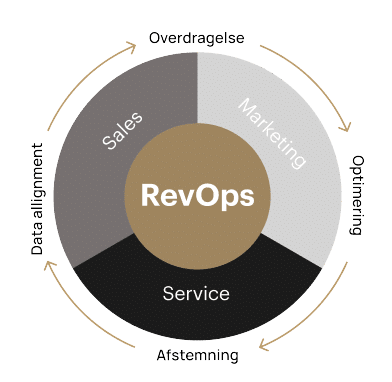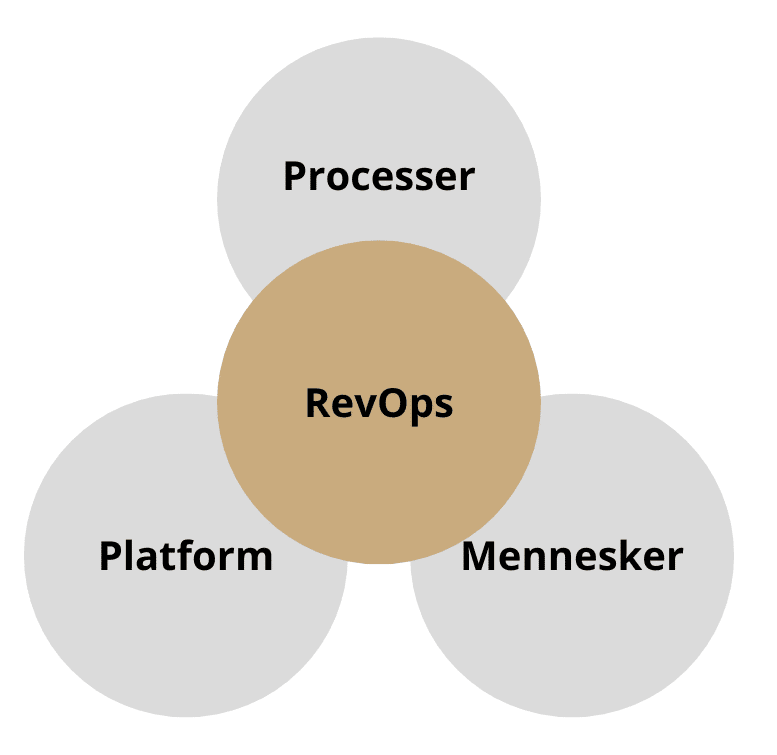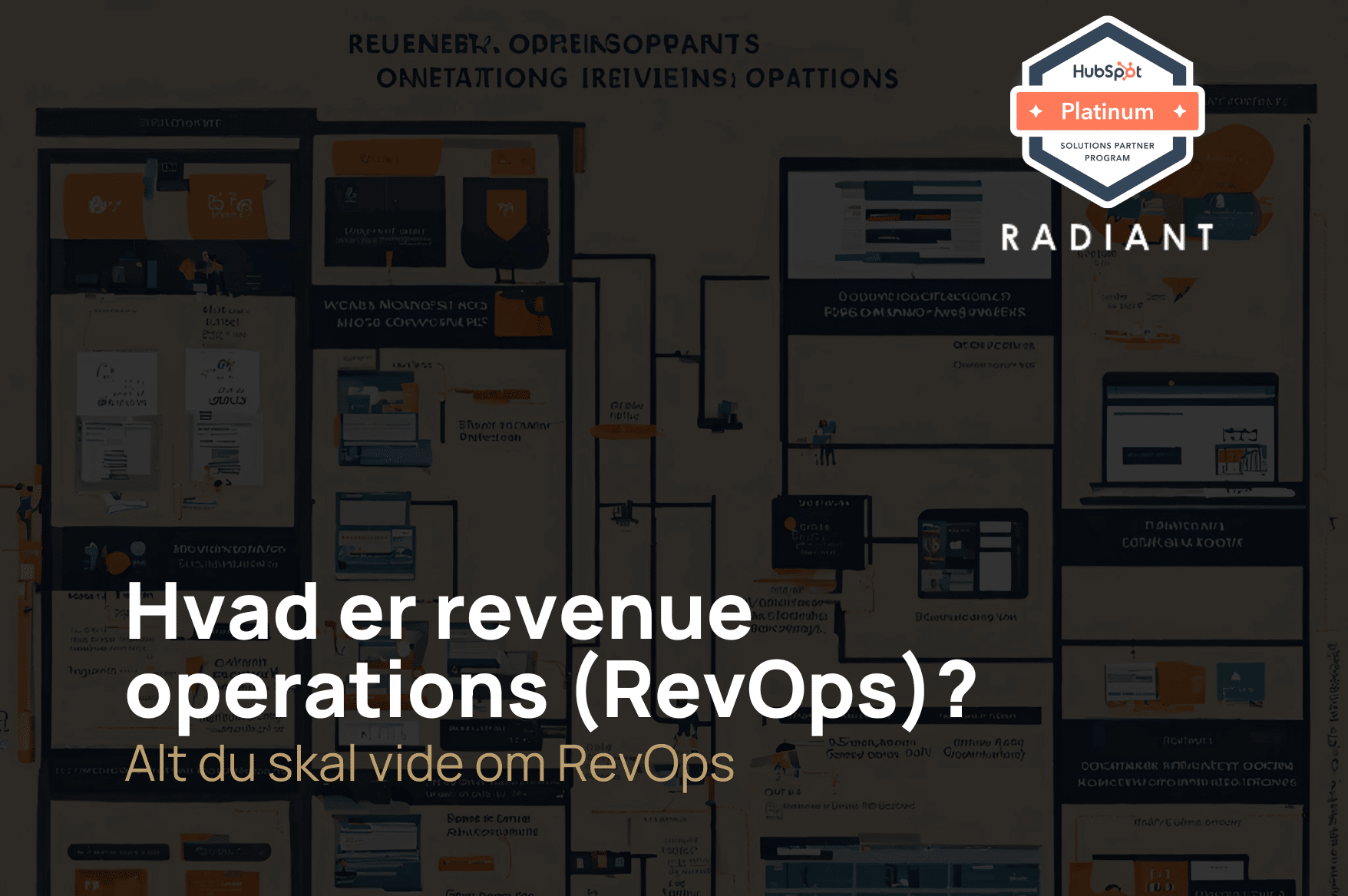Revenue operations, also known as RevOps, is a focus area/role within the automation and optimisation of processes between sales, marketing and customer service.
In recent years, RevOps has started to gain momentum in the US and more and more European companies have started to adopt the concept too. Gartner predicts that 75% of high-growth tech companies will employ a RevOps position by 2025.
In this article, we take a look at the following:
- What is revenue operations (RevOps)?
- RevOps consists of 3 parts
- What can I get out of revenue operations?
- 6 steps to get started with RevOps
- Get help with RevOps with Radiant
What is Revenue Operations (RevOps)?
Revenue operations (RevOps) is a function that aims to optimise internal processes and systems so that sales, marketing and customer service work better together.
The purpose of revenue operations is to make internal processes better and smarter while ensuring the best customer experience. If you used to find your new customers by searching online, a RevOps manager’s job is to make this smarter with the help of technology and automation.
If you work in revenue operations, your responsibilities include:
- Handover from marketing to sales
- Handover from sales to customer service
- Sales, marketing and service have clear processes
- That the three departments have the data they need

RevOps consists of 3 parts
To ensure all processes are running smoothly, a RevOps manager works with three areas: processes, systems and people.
Processes
Map processes for sales, marketing and customer service workflows. Therefore, it must be identified and defined where it makes sense to optimise the company’s processes.
The processes need to be built in collaboration with the relevant employees, recognising that some things have always been done one way and that employees will often be resistant to change.
Platform
It’s important to have a single source of truth in the organisation – a unified platform, such as a CRM system, that ensures everyone is working with a complete overview of what the status of a customer or potential customer is.
People
It’s not enough to work on how to optimise processes in the company if you don’t also work with the people who have to follow and execute the processes.
For example, there is a big difference between creating processes for an organisation with an average age of 60 versus an average age of 30, as the issues and opportunities you face are typically different. It is therefore important that processes are optimised with people at the centre.

What can I get out of revenue operations?
The purpose of revenue operations is to ensure that you increase revenue and reduce costs in your organisation. To achieve these benefits, RevOps aims to remove bottlenecks in processes and identify new opportunities to improve the customer experience.
In this way, RevOps will help to create:
- Greater predictability in terms of forecasting and budgeting
- Better customer relations as a result of improved internal processes
- More clarity for sales, marketing and customer service on status and priorities
With RevOps, you can achieve faster growth and higher profitability.
6 steps to get started with RevOps
Do you want to get started with RevOps but aren’t sure what it takes? Below you’ll find 6 steps you can follow to get started with revenue operations in your organisation.
1. Give or take ownership of your organisation’s RevOps
RevOps is an organisationally anchored function. It’s not just managed with internal alignment of expectations between the three departments – it’s a role with a special responsibility. To ensure you get off to a good start with RevOps, you should start by deciding where the responsibility lies.
There are typically two ways to approach this:
- One person each from sales, marketing and customer service will be assigned the task as part of their other work. The three then work together and report to a superior, such as the CEO, who is the most senior person responsible for the task.
- Alternatively, you can create a dedicated Revenue Operations role that a specific person fulfils on a dedicated basis. They will draw on resources from sales, marketing and customer service and typically report to the Executive Board.
It’s up to you which model you prefer – the important thing is that you officially delegate responsibility for your organisation’s RevOps.
2. Identify your needs
Review your internal processes in sales, marketing and customer service and see if there are any gaps in the process. Therefore, consider the following:
- Do you know what happens at each stage of the sales process and how marketing transfers leads to sales?
- Is marketing working with a different audience than sales?
- Are you missing marketing content that sales has?
- Are the relevant people using the systems you’ve invested in, or do you actually have information that more people in the organisation could use?
The above are problems/opportunities that you need to identify and pinpoint so you can better prioritise where to take action.
3. Map and evaluate the customer journey
In order to prioritise correctly, it is essential that you analyse the customer journey. You may want to investigate the following:
- What are the steps in the customer journey?
- Where and how does the customer interact with your business?
- What happens internally when a customer interacts with your organisation?
Use these questions to uncover where bottlenecks are occurring and where there is a lack of consistency in the customer journey. This is an obvious place to identify where manual processes can be automated to better scale your business.
Also read: ‘Good customer service with 10 concrete tips’
4. Create a plan for revenue operations
Once you’ve identified gaps in your processes, systems and customer journey, you need to prioritise. Once you’ve identified gaps in your processes, systems and customer journey, you need to prioritise.
Most people don’t like other people coming in and telling them how to do their job. Therefore, it’s a good idea to start where you can achieve the greatest impact and where you can ensure that the fewest different people need to be involved.
Once these optimisations are successful, they will naturally spread through the company and more people will automatically ask for help. This way, your RevOps initiatives will organically become an integral part of your organisation’s processes.
5. Create a single source of truth
One of the most important elements of RevOps is valid, consistent customer data. That’s why it’s important to ensure you have a single source of truth in the form of a CRM system where you can collate your organisation’s customer data.
We recommend that you do the following:
- Clean up your data: Inconsistent data makes it difficult to automate processes. That’s why it’s important to clean up your data so you can ensure good data quality through your optimised processes.
- Eliminate duplicate software: Many businesses use an incredible number of different pieces of software in their operations – and typically more than they need to. Eliminate the unnecessary solutions and integrate the rest into your CRM system.
- Streamline your departments: If possible, choose one CRM system so that sales, marketing and customer service always work from the same CRM data. If you don’t, it’s crucial that all your systems are seamlessly integrated to ensure that all data is consistent across the three departments.
Read more about CRM systems here: ‘What is CRM?’
6. Build your engine
Now we get to where the value lies. You need to build processes for how you can do things smarter. When it comes to building, you need to consider:
- Input from others: It’s always important to ask for feedback from those who work with the processes on a daily basis. But also remember that they’ve always done things the same way, so if they wanted to optimise, they probably would have done it.
- Ease of use: When building your engine, remember that while it may seem smarter, it also needs to be user-friendly so it can be put into practice.
- Test: Avoid silly mistakes and test your new processes before going live. It may sound obvious, but it’s often forgotten – and it can be costly if customers are lost because you haven’t tested your systems.
Get help with RevOps with Radiant
At Radiant, we work daily with revenue operations and the optimisation of processes in sales, marketing and customer service and the synergy between them.
We have helped more than 100 companies with these processes. That’s why we’ve collected best practices, learned from a lot of mistakes and seen where and what to prioritise and vice versa.
We’ve found that RevOps works best with HubSpot. That’s why we only work with companies that invest in this or have done so. Because the result just gets better. Revenue operations går under vores service, HubSpot as a Service.
If you want a mapping of your potential within RevOps, we are happy to make a non-binding introduction so you can learn more about how we do it.




